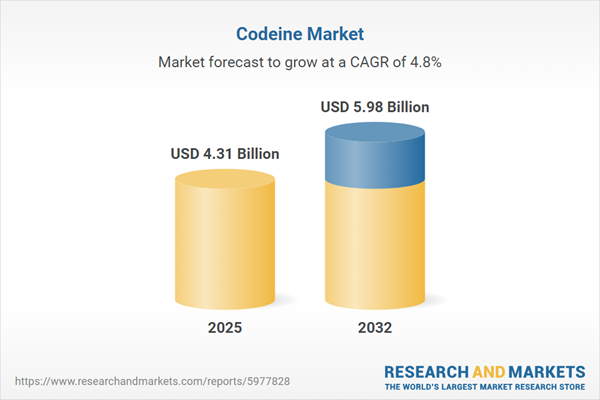Speak directly to the analyst to clarify any post sales queries you may have.
The global codeine market is evolving rapidly as organizations respond to changing regulatory requirements and optimize operational frameworks. Senior decision-makers are focusing on compliance and innovation, positioning their companies to address new risks, operational challenges, and growth opportunities.
Market Snapshot: Growth and Opportunities in the Codeine Market
The codeine market is progressing, shaped by increasing therapeutic demand and shifts in the global regulatory environment. Recent analyses indicate a compound annual growth rate and notable expansion in market size, advancing from a base of USD 4.11 billion in 2024 to a projected USD 5.98 billion by 2032. This acceleration is driven by investments in patient-centric approaches, enhanced compliance infrastructure, and operational agility. Strategic leaders are steering organizational priorities toward efficiency, product portfolio optimization, and maintaining competitiveness within evolving healthcare delivery models. The landscape is further impacted by intensifying competition and a growing emphasis on operational responsiveness.
Scope & Segmentation: Strategic Landscape of the Global Codeine Market
- Product Type: Codeine hydrochloride, codeine phosphate, codeine sulfate, and various combination formulations dominate the market, supporting product life-cycle strategies and risk management approaches as standards adapt globally.
- Form: Injections, sugar-based syrups, sugar-free syrups, and tablet formats, including immediate- and extended-release versions, are prioritized to meet patient and prescriber needs. Innovations in packaging and reliability in distribution have become critical for sustained engagement and patient adherence.
- Application: Primary use cases revolve around cough suppression and pain relief, with protocols tailored to distinct healthcare settings and patient groups. Understanding application nuances allows for more precise care provision and resource management.
- Distribution Channel: Hospitals, retail pharmacies, and online platforms form the core sales and distribution mix. Integration of digital health tools expands access, closes infrastructure gaps, and supports improved delivery performance.
- End User: Clinics, hospitals, and home care providers require adaptable service models that reflect diverse regulatory policies and allow for rapid adjustment to changing care environment requirements.
- Region: The Americas, Europe, Asia-Pacific, and Middle East & Africa each present distinct policy landscapes and healthcare systems, shaping compliance, operational adaptation, and market entry strategies for organizations at all stages.
- Representative Companies: Major players such as Johnson & Johnson, Sanofi S.A., Teva Pharmaceutical Industries Ltd., Viatris Inc., Sandoz International GmbH, GlaxoSmithKline plc, Aurobindo Pharma Limited, Cipla Limited, Dr. Reddy’s Laboratories Limited, and Sun Pharmaceutical Industries Limited set market benchmarks and execution standards.
Key Takeaways for Codeine Market Strategy
- Rising regulatory supervision is driving the adoption of abuse-deterrent product solutions and heightening the importance of compliance-related R&D activities.
- Digital health technologies and telemedicine are enabling organizations to redesign service delivery, improving patient access and aligning care with emerging health trends.
- Strategic partnerships and flexible distribution models provide competitive advantages, particularly as organizations recalibrate to serve dynamic market requirements.
- Adaptability in regional markets supports targeted entries and expansion while ensuring organizations remain responsive to distinct legal and compliance frameworks.
- Building robust, data-informed supply chains enhances business resilience and maintains reliable access to market intelligence in the face of geopolitical volatility.
Tariff Impact: Navigating US Tariff Regime and Global Supply Chain Adjustments
With new US tariffs on codeine and its intermediates set for implementation in 2025, manufacturers are reassessing sourcing and supply chain strategies. To mitigate trade disruption, companies are diversifying supplier networks and forming strategic local partnerships, aiming to secure procurement pathways and uphold supply chain continuity in a volatile trading environment. These changes are crucial for maintaining uninterrupted market access amid evolving global trade dynamics.
Methodology & Data Sources
This report synthesizes primary interviews with industry executives and academic experts with quantitative validations from peer-reviewed research and official regulatory documents. Scenario modeling and triangulation ensure robust, actionable insights for strategic planning and risk management.
Why This Report Matters to Senior Decision-Makers
- Delivers a tailored action plan for operational and strategic adjustment, supporting the development of robust responses to regulatory, compliance, and supply chain challenges.
- Empowers leadership teams to effectively align innovation and compliance initiatives, enabling organizations to adapt to a fluid market environment while protecting organizational interests.
- Provides data-driven analysis and practical frameworks for effective decision-making under shifting regulatory and market pressures.
Conclusion: Codeine Market Leadership Requires Strategic Agility
Companies that emphasize regulatory compliance, operational adaptability, and innovation are positioned to strengthen resilience and seize new opportunities as the codeine market continues to transform.
Additional Product Information:
- Purchase of this report includes 1 year online access with quarterly updates.
- This report can be updated on request. Please contact our Customer Experience team using the Ask a Question widget on our website.
Table of Contents
3. Executive Summary
4. Market Overview
7. Cumulative Impact of Artificial Intelligence 2025
Companies Mentioned
The companies profiled in this Codeine market report include:- Johnson & Johnson
- Sanofi S.A.
- Teva Pharmaceutical Industries Ltd.
- Viatris Inc.
- Sandoz International GmbH
- GlaxoSmithKline plc
- Aurobindo Pharma Limited
- Cipla Limited
- Dr. Reddy’s Laboratories Limited
- Sun Pharmaceutical Industries Limited
Table Information
| Report Attribute | Details |
|---|---|
| No. of Pages | 191 |
| Published | October 2025 |
| Forecast Period | 2025 - 2032 |
| Estimated Market Value ( USD | $ 4.31 Billion |
| Forecasted Market Value ( USD | $ 5.98 Billion |
| Compound Annual Growth Rate | 4.7% |
| Regions Covered | Global |
| No. of Companies Mentioned | 11 |









